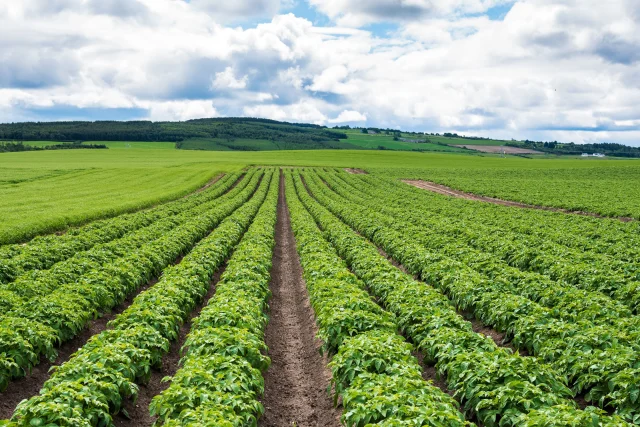Published on 30th March 2022
Local Insights
Seven top tips for crop agronomy this April in the Midlands

Ben Frost outlines his advice for the coming month for combinable and root crop growers
Seven top tips for crop agronomy this April in the Midlands Content
Crop Progress
Wheat across the board is looking well. Most crops are late tillering, or approaching GS30 in early drilled crops as we approached the end of March. There was quite high levels of Septoria on leaf five, as confirmed by our National Snapshot testing, but not a lot of yellow rust.
Residual herbicides in wheat worked well last autumn, particularly where Proclus (aclonifen) was used with Liberator (flufenacet + difufenican). Growers have been applying mesoulfuron-based contact herbicides in March, such as Pacifica Plus (mesosulfuron + iodosulfuron + amidosulfuron) to tidy up any grass weeds that made it through the autumn. Large diurnal temperature fluctuations with night-time frosts have meant growers needed to be a bit careful with applications to avoid some crop effects.
Winter barley was really on the move, with T1 approaching quickly. Oilseed rape had also moved a lot in the past two weeks to green bud stage, and a start has been made to sugar beet drilling.
Larger potato producers have made a start to planting in recent weeks, but many growers will be waiting to the first week of April due to wetter soil conditions further down in the soil profile. The drilling of carrots, parsnips and onions sets is also underway.
The planting of vegetable brassicas such as calabrese and cauliflowers under fleece is under way in south Lincolnshire. While commodity prices are supporting investment in combinable crops to some extent, the rise in fertiliser price, fertiliser delivery issues and fuel prices are making things much more difficult for potato and brassica growers.
Ben’s agronomy tips for April
1. Knock out yellow rust at T0
As I write T0s are quickly approaching which is a vital start to controlling yellow rust. Tebuconazole is the most effective azole at this timing providing quick knockdown of yellow rust, while the addition of a strobilurin fungicide to tebuconazole can bolster protection particularly on varieties with low yellow rust resistance scores.
It’s important to start your yellow rust control programme off well at T0, as some of the largest fungicide responses in recent years have come from varieties with the lower yellow rust resistance scores.
I wouldn’t necessarily treat all crops at T0. If there is yellow rust in the crop then yes knock it out to reduce pressure at T1, but if there’s not any yellow rust there it’s not necessarily needed. November and December drilled crops progress quickly in the spring and sometimes don’t require a T0, but watch out for mildew at the T0 timing in these crops. Later sowings can also be more susceptible to yellow rust than early sowings.
T0 is also a useful timing to start growth regulator programmes, apply micronutrition and tidy up any overwintered weeds which can’t wait until T1, such as cleavers, groundsel or volunteer beans.
2. Careful dissection required to identify leaf three for T1s in wheat
Careful dissection of the plant is crucial to make sure you are applying T1 fungicides to the right leaf layer. The correct timing is leaf three fully emerged, but you need to be careful as this could coincide with GS31-32 in early crops and GS30 in late crops.
Prothioconazole is a vital start to a fungicide programme in my opinion. It delivers protection against Septoria and yellow rust but is also the best azole fungicide for eyespot and fusarium activity, plus gives useful protection against mildew.
Eyespot at T1 is a disease which is sometimes overlooked with the risk higher in second wheats and early drilled crops. There’s also quite a lot of “clean” varieties on the Recommended List which have low scores for eyespot, including Extase (3) and Graham (3).
Ascra (bixafen + fluopyram + prothioconazole) is a go to product at T1, giving a good dose of PTZ with two complementary SDHIs in the can. It delivers good levels of disease control all round.
The two SDHIs are from different classes within the SDHI fungicide group, so there’s incomplete cross-resistance between them so it helps deliver robust levels of Septoria control, even in the absence of Folpet.
Ascra can also provide physiological benefits to the crop, increasing chlorophyll content/photosynthesis in treated plants, and extending green lead area retention, helping to increase yield over and above that from disease control alone.
A standard recommendation would be 1.0 L/ha but you can push that up to 1.2 L/ha where disease pressure is higher. Using our CropCheck service before T1 will help get a sense of disease pressure, as well as the usual factors of weather, variety and visual inspection of crops.
3. Position Ascra in winter barley at T1
The biggest response from fungicides comes from the T1 spray (GS30/31) in winter barley, so this would be where I would recommend positioning Ascra, which now has a label recommendation for the crop.
You can only use it once though, so my choice is at T1 at a rate of 0.9 L/ha, where it gives good levels of net blotch control over other market standards, as well as good all round disease control of other key diseases such as Rhynchosporium.
It does also deliver good levels of Ramularia protection, so if that’s your bigger concern then you can delay its use until T2 (GS37-49) where a rate of 0.7 l/ha should be used.
In a lower risk situation Siltra (0.6 L/ha) is also a good option, and obviously you need to react to the disease pressure.
4. But in spring barley save Ascra for T2
Where soil conditions allowed some growers made a start to drilling spring barley early, but the majority will be being drilled in March and April.
One thing to note for any being drilled in April is that Liberator (flufenacet + diflufenican) has an on-label approval for weed control in spring barley, but it is pre-emergence only which is different to the EAMU you might have previously used.
First fungicide sprays on the early drilled crops might be in April – the target timing is GS25-30. My standard would be Siltra at 0.4 L/ha at T1. Unlike winter barley the greatest return on fungicide investment usually comes from T2, so I’d suggest leaving Ascra (0.7 L/ha) for T2 (GS39-45), which shouldn’t be any more than 25 days after T1.
5. Protect oilseed rape crops from light leaf spot and Sclerotinia
Varieties such as DK Extremus, DK Expedient and DK Exstar have really stood out for their spring vigour in the past few weeks. When you drill earlier to avoid adult cabbage stem flea beetle grazing, you get less adult grazing but usually more larvae in stems. Early nitrogen and varieties with good spring vigour help mitigate against the effects of the larval damage.
Crops were rapidly approaching flowering when this was written. Aviator (bixafen + prothioconazole) at 0.75 L/ha at early to mid-flowering will give good levels of light leaf spot protection and an uplift in Sclerotinia over many of the other market standards.
In Forward Farmer grower strip trials that has translated to a benefit of 0.3 t/ha over the farmer’s usual standard treatment. Aviator has also performed well in AHDB fungicide performance trials.
6. Apply Emerger weed control as soon as possible after potato planting
Most potato crops in the region will be planted in April, and it is important if using Emerger (aclonifen) to apply it as soon as possible to settled ridges after planting, and at least seven days before the crop emerges.
In combination with Artist (flufenacet + metribuzin) it gives a good start to weed control of both broadleaf and grass weeds. That mix gives a good uplift in cleavers and cranesbill control over Artist plus metrobromuron, and an uplift in sow thistle and charlock over Emerger plus pendimethalin.
With regards to potato cyst nematode control, it’s important to maximise cultural controls such as considering rotation, variety resistance and tolerance, testing PCN population levels, using certified seed and potentially employing trap cropping or biofumigants. But at this stage the use of nematicides is the last option, other than not planting very high-risk fields.
Our liquid nematicide Velum (fluopyram) is a useful tool for PCN control with the flexibility to either apply with a boom sprayer following destoning or onto ridged beds where no destoning is needed, or at planting via a liquid applicator as an in-furrow treatment.
Velum in trials has delivered a 3.7 t/ha uplift over untreated controls when used alone in low to moderate pest pressure, but in high pressure use with 15 kg/ha Nemathorin.
7. Minimise risk to sugar beet crops from herbicides
Weed control programmes in sugar beet crops must start when weeds are small at around expanded cotyledon stage of the beet.
I’d start with 1.0 L/ha Betanal Tandem (phenmedipham + ethofumesate) in combination with a residual, such as metamitron or lenacil. Follow up with 1.5 L/ha of Betanal Tandem plus residual 10-14 days later. These applications should be made with a water volume of 80-100 L/ha.
All these applications should be made with suitable adjuvant oil such as 95% methylated rape seed adjuvant oil or 95% methylated vegetable adjuvant oil, and it is vital that the rate of oil used is varied according to the maximum temperature on the day of spraying.
That will help minimise the risk of any check on crop growth which is important not just for the health of the beet, but also in getting to 12 true leaves as quickly as possible when the risk from aphids transmitting virus yellows reduces.
More Conviso Smart sugar beet is being grown this season, which is a highly efficient and convenient way of controlling weeds in sugar beet. In most cases you should only need the one spray of Conviso One (foramsulfuron + thiencarbazole-methyl), including no need for a graminicide.
Conviso One gives good levels of control of polygonum weeds, annual mercury, fools parsley and obviously takes out conventional weed beet.
The application details are important as you only have one shot – apply it at 1.0 L/ha in 150-300 L/ha water, when fat hen is at 2-4 TL and the crop 4-8 TL. Delaying application past fat hen being at 4 TL could compromise efficacy of weed control. Don’t mix with any other herbicides.
Also concentrate on the stewardship of Conviso beet – for bolter prevention drill at a time appropriate the variety and field and later in the season remove any bolters from the field before their seed is viable.



